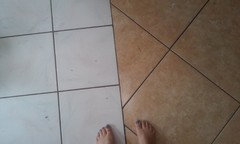

Using rectangular tile on floors can make small rooms appear larger than they really are, and when you continue the tile up the wall vertically, it can make the ceiling appear higher as well. Squares and rectangles are the most common floor tile shapes, but there are lots of linear and plank products that offer long, short, wide, and narrow dimensions on the market too. Conversely, using large-format tile or slab products can create a fluid effect that plays into a minimalist or ultramodern setting. For example, although a large floor area can handle supersized tiles, mosaic or small square tiles are most likely the best choice for a kitchen backsplash. But even in a small room, using the largest tile that is still appropriate for the application means fewer grout lines, and results in fewer visual interruptions.Īs for other tiled surfaces in the room, use a mix of small or midsize tiles to create visual interest and add scale to the room. 45 degrees), this installation will also require some kind of “straight edge break” border between the change in pattern or direction–even if continuing with the same flooring material.A floor's tile size affects the overall design of a room, and the larger the space, the larger the floor's format. If materials will be meeting each other at any kind of angle (i.e. You’ll need long straight-edged borders to keep the emphasis off the joint or awkward short-cut edges of either material.

Some people prefer no emphasis (such as a thin decorative strip) between material borders and simply want to lay a low-profile bead of silicone caulk into the joint between the materials. If the adjacent material will be set at an angle, it might also be decided that that material also include its own border. Some people choose not to use a border to cap the cut plank ends if the adjacent material is large enough to function as its own straight-edge in contrast to the cut planks.

The wood border caps the cut plank ends, and also provides a continuous straight-edge border for the tile installation.

If hardwood plank flooring lies perpendicular to a tile flooring (short, cut ends border the tile), it’s usually best to border the wood in its own material (1-2 rows depending on thin/wide plank width) before starting the transition to tile. Each of these considerations is addressed below:
#Different tiles in adjoining rooms install#
With a little creativity and planning discussions with your installer, you should be able to pleasantly solve any flooring transition problem!Ĭonsiderations when transitioning flooring from tile to wood or some other material include: aesthetics, location of install, install techniques, underlayment, thickness of materials, thin set application, floor height variations, and order of install. If additional construction isn’t an option, planning and decisions will still be required in deciding what kind of “sloped transition strip” or “threshold” will mitigate your flooring transition. Foremost a design aesthetics issue, flooring transitions are also a functional issue.Īchieving a same-height or “flush” transition between flooring materials requires pre-planning and possibly extra construction expense.
#Different tiles in adjoining rooms how to#
If remodeling by sections (and not doing an entire ground-up tear-down or starting with new construction) there will often be different floor-heights for each flooring material in addition to the basic decision about how to visually “end” and cap material A, and start material B. There comes a time in every homeowner’s life when they are faced with how to mediate a flooring transition from one material to another, such as hardwood to tile, carpet to tile, or laminate to tile or natural stone. Handling Wood to Tile Transitions or Carpet to Tile Transitions


 0 kommentar(er)
0 kommentar(er)
